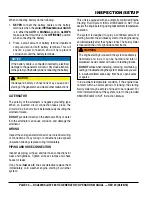
PAGE 54 — DCA300SSJU4F2 60 HZ GENERATOR • OPERATION MANUAL — REV. #0 (06/26/18)
MAINTENANCE
SELECTIVE CATALYTIC REDUCTION (SCR)
Diesel engines can be run with a lean burn air-to-fuel ratio,
to ensure the full combustion of soot and to prevent the
exhaust of unburnt fuel. The excess of air necessarily leads
to generation of nitrogen oxides (NO
x
), which are harmful
pollutants, from the nitrogen in the air.
Selective Catalytic
Reduction
is used to reduce the amount of NO
x
released
into the atmosphere.
Diesel Exhaust Fluid
(DEF) from a separate tank is
injected into the exhaust pipeline, where the aqueous urea
vaporizes and decomposes to form ammonia and carbon
dioxide. Within the SCR catalyst, the NO
x
are catalytically
reduced by the ammonia (NH
3
) into water (H
2
O) and
nitrogen (N
2
), which are both harmless; and these are then
released through the exhaust.
The SCR system creates a certain amount of ammonia
(NH
3
) that is stored in SCR catalyst. During purging
operations the increase in temperature at regular intervals
eleminates the stored ammonia.
The process of keeping accurate amonia storage amounts
is by counting urea injection quantities from the Dosing
Control Unit (DCU)
The SCR Purge symbol (Figure 74) will be displayed on the
ECU controller during operation when either an
automatic
or
forced
system purge operation is in process.
The pre-alarm lamp is only
ON
during SCR forced system
purging and
OFF
during automatic system purging
Figure 74. SCR Purge Symbol
Series 800 Controller
ECU
Engine Started
Shutdown
Pre-Alarm
Alarm
Acknowledge
Screen
Change
Program
Exit
Option
SCR PURGE
SYSTEM PURGING GUIDELINES
For safe operation of equipment, the surrounding area and
the prevention of bodily harm, use the guidelines below
when system purging is required:
DO NOT
operate the unit in area with poor ventilation.
If operating the engine indoors, install exhaust/ventilation
equipment and ensure that there is sufficient ventilation.
If you begin to feel sick, stop the unit immediately and
ventilate the area.
Exhaust emissions from the tailpipe have a smell different
from those emitted from engines without urea SCR
systems due to the exhaust emission reduction functions
of the exhaust system.
NOTICE
During urea SCR system purging,
white smoke
may
be emitted from the exhaust tailpipe temporarily this
shoud not be considered a failure. In addition the smell
of
ammonia
during the purging process should not be
considered a failure.
If the purging process is underway while running a light
load (0-35%) the unit may produce unusual sounds.
This should not be considered a failure or malfunction.
NOTICE
DO NOT
perform purging in conditions where it may be
unsafe due to high exhaust temperatures.
NOTICE
The area above and around the generator during the
purging process should be free of any type of debris,
flammable or combustible materials, as temperatures
during the purging process can reach as high
1,022 °F (550 °C).
















































